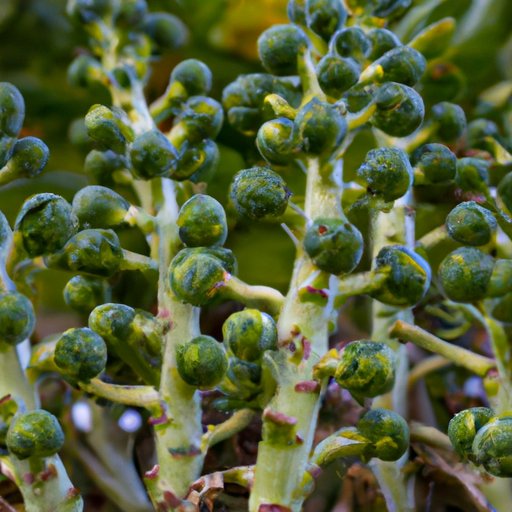Introduction
Brussels sprouts are a nutritious and delicious member of the cabbage family. These small, green veggies are packed with vitamins and minerals like vitamin K, vitamin C and folate that promote good health and prevent disease. Growing your own Brussels sprouts can be a fun and rewarding experience, giving you the opportunity to enjoy fresh, home-grown produce throughout the winter months. In this article, we will cover everything you need to know to successfully grow Brussels sprouts.
Defining the Necessary Conditions for Growing Brussels Sprouts
Before you start planting, it’s important to understand the optimal conditions for growing Brussels sprouts. These plants require well-draining soil that is kept consistently moist, but not waterlogged, with a pH level between 6.0 and 6.8. Brussels sprouts also prefer cool temperatures and moderate to high humidity.
Preparing the Soil for Planting Brussels Sprouts
Start by testing your soil’s pH level, which can be done with a simple soil testing kit. If the pH level is outside of the recommended range, you can make adjustments by adding lime to raise the pH or sulfur to lower it. Once you have your soil pH balanced, it’s time to add proper nutrients. Brussels sprouts require nitrogen, phosphorous and potassium to grow well, so it’s important to use a fertilizer formulated for vegetables. Work the fertilizer into the top 6 inches of soil before planting. Choose a spot in your garden that receives full sun or partial shade and has good drainage.
Starting Brussels Sprouts From Seeds
The best time to start Brussels sprout seeds is in mid to late summer, about 100 days before your first expected frost. Start the seeds indoors in a seed tray filled with seed-starting mix. Keep the soil moist and warm, with temperatures between 70-85°F. When the seedlings emerge, move them to a bright, sunny window or under grow lights, keeping the soil moist but not waterlogged.
Transplant your seedlings to the garden when they are 5-6 weeks old and have at least two sets of true leaves. Space them 2-3 feet apart in rows 3-4 feet apart. Plant them at the same depth as their previous growing container and be careful not to damage the roots.
Caring for young plants
Water your young plants deeply and regularly, aiming to keep the soil evenly moist. Mulching around the plants can help maintain moisture levels and provide a barrier against weeds. Keep an eye out for pests like aphids, cabbage worms and flea beetles. You can handpick these insects or use organic pesticides. Covering your young plants with lightweight row covers can also protect against pests while still letting in sunlight and air.
How to Care for Your Brussels Sprouts
Monitor your Brussels sprouts throughout the growing season for signs of pests and diseases. Common issues include black rot, clubroot and powdery mildew. If you spot any problems, make sure to remove and dispose of affected leaves or plants.
Brussels sprouts can also suffer from nutrient deficiencies, such as nitrogen, phosphorous or potassium deficiency. A general vegetable fertilizer should be added to the soil every 4-6 weeks during the growing season to prevent these issues.
Throughout the growing season, continue to regularly water your plants and keep them free of weeds. If your plants are tall and spindly, consider staking them to protect against wind damage.
Harvesting and Storing Brussels Sprouts
Brussels sprouts mature in about 90-180 days depending on the variety, and are typically harvested once the buds reach their full size (about 1-2 inches in diameter). Harvest from the bottom up, removing the lower, larger sprouts first. You can leave the top of the plant to continue growing and producing more sprouts.
After harvesting, remove any dead or yellowing leaves from the plant and store the sprouts in the refrigerator for up to 3 weeks. Alternatively, you can blanch and freeze them for longer storage.
Conclusion
Growing Brussels sprouts can be a fun and rewarding experience, providing fresh, nutritious produce throughout the winter months. By following these tips, you can successfully grow your own Brussels sprouts from seedling to harvest. Don’t be afraid to experiment with different varieties and growing methods.
